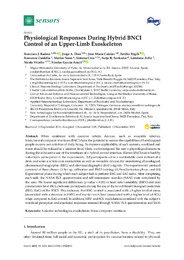Título :
Physiological Responses During Hybrid BNCI Control of an Upper-Limb Exoskeleton |
Autor :
Badesa, Francisco J.
García Aracil, Nicolás
Catalán, José María
Zollo, Loredana
Díez, Jorge A.
Crea, Simona
Nann, Marius
Cordella, Francesca
Trigili, Emilio
Vitiello, Nicola
Soekadar, Surjo R. |
Editor :
MDPI |
Departamento:
Departamentos de la UMH::Ingeniería de Sistemas y Automática |
Fecha de publicación:
2019 |
URI :
https://hdl.handle.net/11000/31255 |
Resumen :
When combined with assistive robotic devices, such as wearable robotics,
brain/neural-computer interfaces (BNCI) have the potential to restore the capabilities of handicapped
people to carry out activities of daily living. To improve applicability of such systems, workload and
stress should be reduced to a minimal level. Here, we investigated the user’s physiological reactions
during the exhaustive use of the interfaces of a hybrid control interface. Eleven BNCI-naive healthy
volunteers participated in the experiments. All participants sat in a comfortable chair in front of a
desk and wore a whole-arm exoskeleton as well as wearable devices for monitoring physiological,
electroencephalographic (EEG) and electrooculographic (EoG) signals. The experimental protocol
consisted of three phases: (i) Set-up, calibration and BNCI training; (ii) Familiarization phase ; and (iii)
Experimental phase during which each subject had to perform EEG and EoG tasks. After completing
each task, the NASA-TLX questionnaire and self-assessment manikin (SAM) were completed by
the user. We found significant differences (p-value < 0.05) in heart rate variability (HRV) and skin
conductance level (SCL) between participants during the use of the two different biosignal modalities
(EEG, EoG) of the BNCI. This indicates that EEG control is associated with a higher level of stress
(associated with a decrease in HRV) and mental work load (associated with a higher level of SCL)
when compared to EoG control. In addition, HRV and SCL modulations correlated with the subject’s
workload perception and emotional responses assessed through NASA-TLX questionnaires and SAM.
|
Palabras clave/Materias:
Assistive technologies
exoskeleton
brain-computer interfaces |
Área de conocimiento :
CDU: Generalidades.: Ciencia y tecnología de los ordenadores. Informática. |
Tipo documento :
application/pdf |
Derechos de acceso:
info:eu-repo/semantics/openAccess
Attribution-NonCommercial-NoDerivatives 4.0 Internacional |
DOI :
https://doi.org/10.3390/s19224931 |
Aparece en las colecciones:
Artículos Ingeniería de Sistemas y Automática
|
 La licencia se describe como: Atribución-NonComercial-NoDerivada 4.0 Internacional.
La licencia se describe como: Atribución-NonComercial-NoDerivada 4.0 Internacional.
.png)
